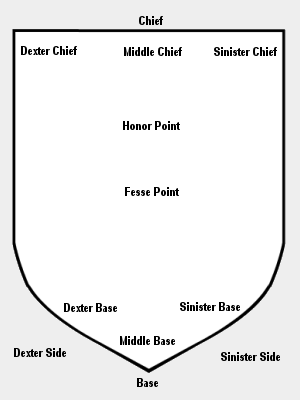Shape

Various shield shapes
The shape of the shield evolved over time. Shields go back in time far beyond the middle ages and they almost always had symbols or creatures painted on them. The earliest and simplest shields in the middle ages were almost triangular in shape with a slight curve on the two downward sides. Examples of these abound from the 13th and 14th centuries.
In the 14th century, even early during the century, two other shapes became popular. In one case the triangular shape was changed so that the two downward sides didn’t start their bend until they were over halfway down the length of the shield. In the other case the top of the shield was given a bend that almost matched the bend in the other two sides of the older version of the shield.
In the second half of the 14th century an entirely new shield form was introduced and it became popular in the 15th century. It is squarish, with concave curves on the sides. The bottom may still have slight angles downward toward the center and the top might have a slight bend upward but the shape was still much more square than older shields. Each side also may have a series of concave curves and typically a notch in one upper corner would be cut out for the lance to pass through.
In any case, a coat of arms (the picture on the shield) does not specify the shield shape to use. This decision is up to the designer and armiger.
Points and Parts

Key points of the shield
As illustrated in the diagram “The key parts of the shield” there are several key terms for different points and parts of the shield. When looking at the shield, the left side is the dexter side and the right side is the sinister side.
The top third of the shield is known as the chief. The bottom third is simply the “bottom” and the middle third is called the fess, but some people only use the term “fesse” when referring to the ordinary type with that name. Regardless, the center point of the shield is called the fess point. Another point exists above the fess point called the honor point.